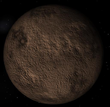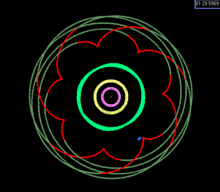Transneptunian object
A trans-Neptunian object (also, trans-Neptunian object) is any object in the solar system whose orbit lies partly or entirely beyond the orbit of the planet Neptune. Some specific subdivisions of that space are called the Kuiper belt and the Oort cloud. By a resolution of the International Astronomical Union on June 11, 2008, the trans-Neptunian dwarf planets were renamed plutoids.
To refer to a trans-Neptunian object, the abbreviation TNO (from English trans neptunian object) is often used. In many cases, it is used interchangeably with the abbreviation KBO (from English Kuiper belt object), which is not entirely correct. TNOs include, among others, Oort cloud bodies and KBOs. The latter, in turn, are also subdivided into plutinos and cubewanos.[citation required]
Due to changes in the orbits of the known planets in the early 1900s, and attributed to the action of gravity (the attractive force between all matter) on the planets themselves, it was assumed that there were one or more more planets beyond Neptune that had not been identified (see planet X). A similar hypothesis had led to the discovery of Neptune, from distortions in the orbit of Uranus. The search for these theoretical bodies led to the discovery of Pluto, and a few significant objects have since been found. However, they are still too small to explain the disturbances, and revised calculations of Neptune's mass showed that the problem was fictitious.[citation needed]
Notable trans-Neptunian objects
In June 2005, the number of these objects was over a thousand, of which a hundred had a precisely determined orbit, and therefore a definitive numbering of the Minor Planet Center.
Kuiper Belt
Kuiper belt objects are often subclassified based on their orbital characteristics. On the one hand, there are objects that orbit in some kind of resonance with Neptune, 2:3, 1:2, 3:5, 4:7, etc. On the other hand, those that are not orbitally linked to Neptune, without orbital resonance of any kind, which are called cubewanos or classical Kuiper belt objects.[citation needed]
2:3 Resonance (plutinos)
With a period of ~250 years, the 2:3 resonance at 39.4 AU is by far the dominant category among resonant objects, with 92 confirmed and 104 possible members. The following objects orbiting in this resonance plutinos are named after Pluto, the first to be discovered. Some important plugins are:
3:5 Resonance
As of October 2008, 10 of these objects had been found. They have a period of ~275 years. These are the three most important:
| Name | Diameter (km) | Perihelio (ua) | Afelio (ua) | Discovery | Year | Image |
|---|---|---|---|---|---|---|
| 2001 YH140 | 345±45 | 36,368 | 48,39 | Brown, Trujillo | 2001 | |
| 1994 JS | 121 | 33,095 | 51,954 | David C. Jewitt, Jane X. Luu | 1994 | |
| 2003 US292 | 2003 |
Resonance 4:7
With a period of ~290 years, another important group (as of October 2008 about 20 objects found) orbiting the Sun at 43.7 AU (in the middle of classical objects). The objects are quite small (with one exception, H>6) and most of them follow orbits close to the ecliptic. Objects with well-known orbits include:
| Name | Diameter (km) | Perihelio (ua) | Afelio (ua) | Discovery | Year | Image |
|---|---|---|---|---|---|---|
| 1999 CD158 | 420 | 37,52 | 49,88 | 1999 | ||
| 2002 PA149 | 2002 | |||||
| 2001 KP77 | 110-240 | 36,021 | 52,020 | Marc W. Buie | 2001 | |
| 1999 HT11 | 146 | 38,858 | 49.231 | Kitt Peak Observatory | 1999 | |
| 2000 OY51 | 2000 |
1:2 Resonance (twotinos)
With a period of ~330 years, this resonance at 47.8 AU is often considered the outer edge of the Kuiper belt, and objects in this resonance are sometimes called twotinos. Twotinos have tilts of less than 15 degrees and eccentricities generally moderate (0.1 < and <0.3). An unknown number of 1:2 resonants probably did not originate from a disk of planetesimals that was swept by the resonance during the Neptune migration, but were captured after they had dispersed.
There are far fewer objects in this resonance (a total of 14 since October 2008) than plutinos. Long-term orbital integration shows that the 1:2 resonance is less stable than the 2:3 resonance; only 15% of objects in 1:2 resonance were stable after 4 billion years, compared to 28% for plutinos. Consequently, twotinos could originally have been as numerous as plutinos, but their populations have fallen. well below that of plutinos ever since.
| Name | Diameter (km) | Perihelio (ua) | Afelio (ua) | Discovery | Year | Image |
|---|---|---|---|---|---|---|
| 2002 WC19 | ~440 | 35,361 | 60.94 | Palomar Observatory | 2002 | |
| 1998 SM165 | 287±36 | 29,902 | 65.154 | Nichole M. Danzl | 1998 | |
| 1999 RB216 | 153 | 33.655 | 61,184 | C. A. Trujillo, D. C. Jewitt, and J. X. Luu | 1999 | |
| 1996 TR66 | 1996 | |||||
| 2000 JG81 | 67 | 34,172 | 61.546 | Silla Observatory | 2000 | |
| 2000 AF255 | 2000 | |||||
| 2001 UP18 | 2001 | |||||
| 2000 QL251 | 2000 |
2:5 Resonance
They have an orbit of ~410 years. In total, the orbits of 11 objects are classified in 2:5 resonance as of October 2008. Objects with well-established orbits at 55.4 AU include:
1:1 Resonance (Neptune Trojans)
Some objects have been discovered with a semi-major axis similar to that of Neptune, near the Sun-Neptune Lagrange Points. These Neptune Trojans are in a 1:1 resonance with Neptune. Nine such objects have been discovered as of October 2012:
- 2001 QR322
- 2004 UP10
- 2005 TN53
- 2005 TO74
- 2006 RJ103
- 2007 VL305
- 2008 LC18
- 2004 KV18
- 2011 HM102
Only the last three are near Neptune's L5, the rest are at L4.
Other resonances
So-called higher order resonances are known for a limited number of objects, including the following:
- 4:5 (35 UA, ~205 years old) 2001 XH255
- 3:4 (36.5 UA, ~220 years) (143685) 2003 SS317, (15836) 1995 DA2
- 5:9 (44,5 UA, ~295 years) 2002 GD32
- 4:9 (52 UA, ~370 years) (42301) 2001 UR163, (182397) 2001 QW297
- 3:7 (53 UA, ~385 years) 2001 XT254, (95625) 2002 GX32, (183964) 2004 DJ71, (181867) 1999 CV118
- 5:12 (55 UA, ~395 years) (79978) 1999 CC158, (119878) 2001 CY224(84% probability according to Emel’yanenko)
- 3:8 (57 UA, ~440 years) 2000 YW134 (82075)(84% probability according to Emel’yanenko)
- 3:10 (67 AU, ~549 years) (225088) 2007 OR10
- 2:7 (70 UA, ~580 years) (471143) Dziewanna, 2006 HX122(The preliminary orbit suggests a weak 2:7 resonance. Further observations are required.)
Some objects are in distant resonances
- 1:3 (62.5 UA, ~495 years) (136120) 2003 LG7, (385607) 2005 EO297
- 1:4 (76 UA, ~660 years) 2003 LA7
- 1:5 (88 UA, ~820 years) 2003 YQ179 (apparently coincidental)
Some notable unproven resonances (which could be coincidence) of dwarf planets are:
- 7:12 (43 UA, ~283 years) Haumea (highly probable nominal orbit in resonance)
- 6:11 (45 UA, ~302 years) Makemake(182294) 2001 KU76 seems also to be in resonance 6:11)
- 5:17 (67 AU, ~560 years) Eris (2007 OR10 is in a similar orbit)
No resonance (cubewanos)
A cubewano, also called a "classic Kuiper belt object" or, in English, classical Kuiper belt object (CKBO), is a trans-Neptunian object that does not meet any type of orbital resonance with Neptune. The peculiar name is derived from the first object of this class, the 1992 QB1; Pronounced in English: /kju:bi wʌn/.
Scattered Disc
Separate Objects
Sometimes considered as outer scattered disk objects. This is a list of known separate objects, which could not be easily dispersed by Neptune's orbit and are therefore likely to be separate objects, but lie within perihelion distance ≈50-75 AU, boundary used that would define the sednoids.
| Name | Diameter (km) | Perihelio (UA) | Senior Semieje (UA) | Afelio (UA) | Arg. per. (°) | Year | Discovery | Image |
|---|---|---|---|---|---|---|---|---|
| 2004 XR190 | 335-850 | 51,49 ± 0,10 | 57.74 ± 0.02 | 64.00 ± 0.02 | 2004 | Lynne Jones et al. | ||
| 2004 VN112 | 130–300 | 47,332±0,004 | 328.8±1.6 | 610±3 | 327.22±0.07 | 2004 | CTIO | |
| 2005 TB190 | ≈ 500 | 46.2 | 76.4 | 106.5 | 2005 | Becker, A. C. et al. | ||
| 2000 CR105 | ≈ 250 | 44,0 | 224 | 403 | 316,5 | 2000 | Lowell Observatory | |
| 1995 TL8 | ≈ 350 | 40,0 | 52.5 | 64,5 | 1995 | A. Gleason | ||
| 2010 GB174 | 242 | 48.5 | 361 | 673 | 347.3 | 2010 | OCFH |
Inner Oort Cloud
The Hills cloud, also called the inner Oort cloud and Inner Cloud, is, in astronomy, a vast and spherical hypothetical inner body in the Oort cloud, the outer edge of which is located at a distance of 2 to 3× 104 AU from the Sun, and whose inner edge, not so sharp, is hypothetically located between 100 and 3000 AU.
Oort Cloud
| Name | Diameter (km) | Perihelio (ua) | Afelio (ua) | Year of discovery | Discovery |
|---|---|---|---|---|---|
| 2006 SQ372 | 50 - 100 km | 24,17 | 2.005,38 | 2006 | Sloan Digital Sky Survey |
| 2008 KV42 | 58.9 | 20.217 | 71.760 | 2008 | Canada Observatory, France, Hawaii |
The hypothetical companion star Nemesis would fit the definition of a trans-Neptunian object, although its existence has not been proven.
Plutino and plutoid
Do not confuse the terms plutino and plutoid. Each one of these categories groups trans-Neptunian objects that, although they may belong to both at the same time, each one has different characteristics as a requirement:
- Pluto-like orbital features are transneptunian objects, regardless of their size.
- Plutoids are transneptunian objects with a size similar to Pluto, regardless of the orbital group to which they belong.
Contenido relacionado
(5000) IAU
(32) pomona
SETI



















